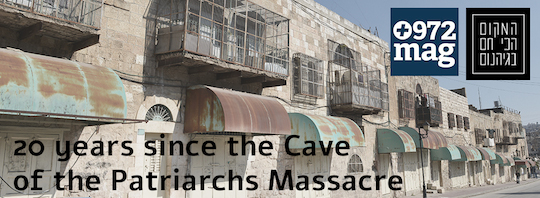Something saddened the Jewish settlers of Hebron following the Cave of the Patriarchs Massacre: the army canceled their Purim parade.
By Yigal Mosko / ‘The Hottest Place in Hell’
Read this post in Hebrew here

Much to my surprise there was no lock on the door. “Does this look safe?” Orna asked. The truth is that it seemed like an irresponsible thing to do, entering Hebron without so much as a single contact while the blood was boiling. Just one day earlier, a doctor from Kiryat Arba by the name of Baruch Goldstein entered the Tomb of the Patriarchs. Dressed in IDF officer garb and using his Galil rifle, he murdered 29 Muslim worshippers and wounded many more, until his ammunition ran out and he was beaten to death with a fire extinguisher.
Along with photographer Orna Itamar, I set out to write an article for Kol Ha’Ir. At the entrance to Goldstein’s home in Kiryat Arba, it was made clear to me that his widow would not agree to be interviewed. We began walking, and not far from Goldstein’s apartment we stopped to look out at Hebron across the fence. After a few moments we realized that someone was calling us. Two hundred meters ahead, on the Hebron side, we saw faces in the window of an unfinished home.
We began our unsuccessful, spontaneous interview by shouting. After a while one of the people in the window invited us to come to them. I thought he was kidding and told them, “we can’t, there’s a fence.” But he pointed toward a small gate in the fence a short distance from us, and said, “go through there.” There is no lock, and we hesitate. In silence, the Arabs in the window look at us, a photographer and a journalist. We go in.
After a short walk we arrived at the house, which was only half built. The walls were not yet plastered and the windows had no panes. Inside there was a big family, including children. It was cold and we were invited to crowd around the bathtub filled with coal that they had put in the middle of the room. First we drink sweet tea, then we start talking.
Like all 120,000 Arab residents of Hebron, they too were placed under curfew by the IDF, which feared riots, until further notice. I do not remember why they were stuck in an unfinished building but at that point they had no choice. They were not upset but it was clear that they were suppressing their anger, and especially their shame over the fact that they, the Arabs, were being punished after a massacre was committed against them.
After a few hours we parted ways and crossed the line back into Kiryat Arba. Now I wanted to return to Hebron, but this time to the Jewish settlement. Although the army didn’t allow it, I managed to catch a ride with Noam Arnon, the eternal spokesperson for the handful of Jews in Hebron. It was already nighttime by the time we entered the city in his car; the soldiers who stood at the entry gate did not demand to see our IDs. We were, however, stopped at a makeshift checkpoint near the Tomb of the Patriarchs by a sergeant and two of his soldiers. None of Arnon’s connections helped.
We continued waiting and eventually stepped out of the vehicle. Arnon and the sergeant struck up a theological conversation. At a certain point, Arnon explained that every person has a soul. The sergeant made a surprising follow-up: “do Arabs also have souls?” As Arnon began fumbling with an answer, the two-way radio announced our redemption, and we continued to the Jewish settlement.
There, too, everyone was angry and in terrible moods. And while no one had massacred them, and no one had placed them under curfew, because of the increased tensions the regional brigade commander canceled their Purim parade that was supposed to take place the following day. Rude. We slept there with a group of young people. (To this day I ask myself whether Yigal Amir, Yitzhak Rabin’s killer, was among them. It was well known that he would spend Sabbaths and holidays in Hebron.) After a few interviews in the morning, we returned to Kiryat Arba with a great sense of relief.
On the sidewalk, we were happy to bump into Kol Ha’ir‘s West Bank correspondent, Hillel Cohen (today a lecturer at Hebrew University). He was on his way to Hebron to walk around the mourner’s tents. A woman pushing a stroller confronted us: “you’re journalists right? Meet my son, Baruch. I named him after the tzadik (righteous person) even before I heard he committed his act of bravery. Dr. Baruch Goldstein, what a tzadik.”
What can I say, I was practically ready to burst after the last 24 hours. “Yalla yalla, get out of here with your Baruch,” I said to the mother from Kiryat Arba. The next day I met with Hillel Cohen at the office. “I ran into that women again,” Cohen said to me. “Just know that she was very offended by you. She told me ‘what kind of journalist is your friend? Okay, I support killing Arabs, he is against killing Arabs, but we can talk about it in a civilized manner!'”
Related:
In Hebron, terror begets a reign of terror
PHOTOS: 20 years since Cave of the Patriarchs Massacre
PHOTOS: IDF brigade commander vs Hebron’s kindergarten
